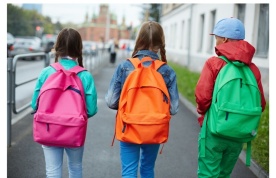
The air that your children breathe in the classroom and the foods they eat during the day all contribute to better academic outcomes. NOW is the time to start thinking ahead and planning from an environmental health perspective. Here are three actions you can take to help your child be their best at school this year.
Protect your children from hidden toxins
What does that mean?
When my grandson enters his kindergarden classroom for the first time, he will probably be wearing new shoes, carrying a new knapsack or lunchbox. And he will take his place in a classroom where all the children have taken baths or showers using body wash and shampoo. Teenagers will be sitting in classrooms next to other students wearing scented deodorant, cologne and hair styling products. Perhaps the classroom will have been painted during the summer and perhaps there is new electronic equipment and furniture in the room. Most of these new purchases, as well as the scented products worn by students and teachers, emit chemicals that pollute the indoor air. Poor air quality can impact children’s health and academic performance.
Here are three easy things you CAN DO to reduce your child’s exposure to environmental toxins:
Create a cleaner breathing zone
- New clothes should be washed before being worn. Fabrics and clothing are usually treated with chemicals. Even if you can’t smell them they are likely there. So when you come home with the new purchases, take off the tags and put them through a cycle in the washing machine.
- New shoes, knapsacks, anything plastic should be aired out. Just like furniture and mattresses, they off-gas in your child’s learning environment.
- Electronic equipment all off-gas toxic chemicals when they are being used. Request that whenever possible the windows in the classroom remain open to improve ventilation.
The lunch box – safe and fun
- If your child takes a bottle for water or juice make sure that it is BPA and BPS free. Warnings that these substances are hormone disruptors are all over the internet. Try to purchase drink containers that don’t contain those chemicals. You can substitute bottles made from stainless steel or glass that is protected with a plastic barrier on the outside.
- The Environmental Working Group publishes a list of the foods most contaminated by pesticides. When possible, try substituting organic for the conventional fruits and vegetables that are the most contaminated.
- The recommended daily intake of fruit and vegetables for school age children ranges from 5-8 depending on the age of the child. That means that the lunch box should contain one or two portions. Choosing the right items for the lunch box helps kids focus and stay energized through the afternoon. The internet is full of creative ideas for creating healthy lunches that are nutritious and fun. Here’s a great starting place!
You can exercise some amount of control when you are packing your children’s lunch. It’s harder to control the air that they breath at school. When the air is fresh and clean it’s easier to concentrate.
Talk to the school
Indoor air is more chemically polluted than outdoor air. It impacts on the ability to learn. Ventilation is extremely important at all times, especially when new equipment and furniture are off-gassing. Keeping windows and doors open will allow a natural draft that will blow out the chemicals that are emitted during that process.
It is the joint responsibility of parents, teachers, students and cleaning staff to decrease the sources of indoor pollutants and provide a cleaner and safer environment. Doing so openly also provides a teachable moment for educators.
And remember the importance of communicating the impact indoor air quality has on children’s health (and the effect it has on their ability to focus).
- Get in touch with the administration of the school. Ask them to make sure that the newly painted rooms and refinished floors are being aired out and new furniture and electronic equipment is off- gassed with windows opened.
- Request that a letter be sent to parents requesting them to refrain from using scented household and personal products. All public institutions should have a scent free policy. If you don’t want your child to breathe a mixture of fragrances all day, speak to the administration and advocate for a scent-free environment.
The first week of a new grade is a perfect time for new beginnings for the whole family. Healthier does require some planning. Now’s the time!
